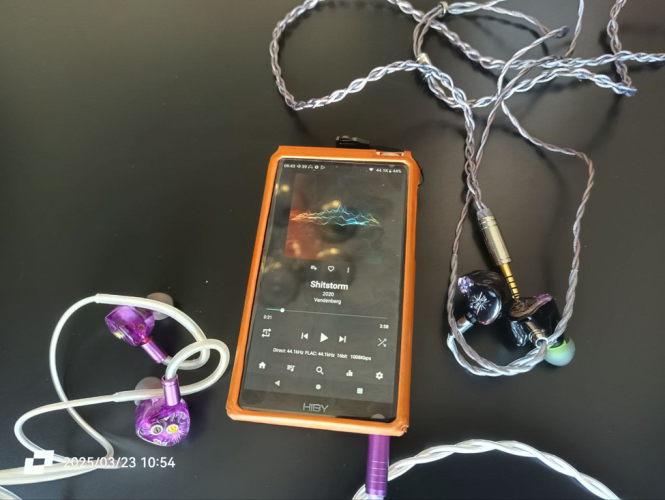alex5908
500+ Head-Fier

Here’s the promised A/B comparison: Kiwi Ears HBB Punch vs TSMR Shock.
For clarity, we'll refer to them as: "Punch" (Kiwi Ears HBB Punch) and "Shock" (TSMR Shock).
Preamble
Test equipment and setup
Hiby RS6 (Darwin Ultra globally)
USB Audio software player in Bit-Perfect mode (OS bypass)
The music used for comparison was a song from Vandenberg (Dutch group) entitled Shitstorm.
Punch requires slightly more amp headroom, i.e. 3 volume steps more (~1.5dB difference).
Fit and comfort comparison
Punch is noticeably heavier and larger in the ear and may cause fatigue during extended listening sessions, while Shock is more compact and anatomically shaped, which is ideal for extended listening sessions.
For the first time for me, in the battle between technicality and musicality, technicality confidently came out on top. Below, I'll explain in more detail what I mean by this.
Both IEMs deliver powerful sound, but the Punch simply pale’s in comparison to the Shock when it comes to this aspect. The Shock absolutely nails you to your seat. And it's not just about sound pressure - there's excellent soundstage separation and remarkable airiness in instrument reproduction. I'm not entirely sure, but this might be related to the Shock's bone conduction technology. Also, the difference in the immersive sound seems to support this notion.
From the first seconds of listening it becomes apparent that these IEMs belong in different leagues and the more you listen, the more convinced you become. The Shock outperforms the Punch across the entire frequency range from highs to lows and the difference is particularly striking in the Lows. Not only do they sound more massive and enveloping but also more layered. For instance, the kick drum is distinctly different from the bass guitar in their reproduction which showcases the Shock’s superior instrument separation.
Now let's break down the frequency range in more detail.
Highs
The Punch exhibits slight muddiness in the highs, yet paradoxically, its treble decay is actually shorter than the Shock's which remains utterly grain-free throughout. On this particular track Shitstorm, percussion/cymbals are barely audible in the Punch. The Shock on the other hand renders them with such clarity that you can distinguish them as left and right positioning. With the Shock, you sense cymbals more than simply hearing them. There's no question that the Shock delivers a significantly more natural high-frequency reproduction, but some might argue different tracks could affect treble performance, but remember - I'm comparing both earphones using the exact same recording.
Lows
Half of the low-frequency detail which is clearly audible in the Shock somehow gets swallowed up in the Punch. The entire weight and mass of the bass seems to be hogged by the Shock, like the blanket your partner constantly steal in their sleep. The only area where the Punch fights back is mid-bass with slightly more punch in kick drums. But when it comes to sub-bass the Shock dominates unquestionably- these are bass-head IEMs through and through. The Shock’s sonic signature is remarkably nuanced and can be tweaked at a hardware level. The layering in the lows is exceptional especially during drum fills, you can easily distinguish between different toms. On the Punch however, it’s like hearing the same tom hit repeatedly.
I now think I get the advantage of the bone conduction present in the Shock: the bass doesn’t just hammer one spot but massages your entire aural periphery. I still remember that surreal first listen - it felt like my eardrums were being kneaded down to the last millimeter.
Low-frequency guitar harmonics (flageolets) rarely appear in music, and even when they do, they’re usually buried under lead guitar tones. But on the Shock, they jump out instantly thanks to stark timbral contrast. What’s truly puzzling is how such powerful, massive lows don’t bleed into the mids, this brings us smoothly to the ‘golden middle’...
Mids
On the Punch, vocals sound more recessed and pushed back from the center stage, while the Shock delivers vocal’s with significantly greater power and body. The difference in guitar reproduction is even more striking - the Shock renders them with an aggressive, biting quality that closely mirrors the raw energy of live concert guitars.
Sound stage/airiness
The Punch delivers a decent soundstage with plenty of width and depth, but the Shock takes it to another level with its immersion. It's like the same track is being performed in completely different venues - say, an intimate concert hall versus a massive arena. I'm exaggerating slightly of course, but the difference in the immersion is undeniable.
My Final Verdict: Kiwi Ears HBB Punch vs. TSMR Shock
First point: I now see why I bought the Shock first and only later added the Punch. Truthfully, the Shock alone would've been perfectly sufficient. I can't fathom why there's been such hype around the Punch - did HBB just execute brilliant marketing prep work and after that it was all bandwagon effect... Really, the industry should be pushing TSMR products harder.
Second point: Outdoors, the sonic differences between the Shock and Punch become far less apparent. High frequencies get noticeably truncated in open environments, and the sub-bass loses its monumental physicality - you won’t feel those earth-shaking lows the same way as you would sitting in your favorite chair in your living room!
P.S.
Ah, what a thrill it is to compare audio gear! If only someone paid us for this - we could confidently declare, now this is a life’s calling!
My frequency response graphs
https://bassyalexander.squig.link/?share=Alexander_Target,KiwiEars_HBB_Punch,Shock
I really appreciate the help rendered by https://www.head-fi.org/members/rumbleweed.396904/ in proofreading the review.






















